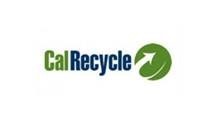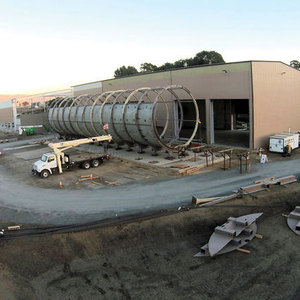Organic Waste to Watts in Wine Country










PHOTO: HITACHI ZOSEN INOVA U.S.A.
March 1, 2018
BY Jim McMahon
San Luis Obispo County, located along the Pacific Ocean in Central California between San Francisco and Los Angeles, is known for its breathtaking seascapes, miles of oak-studded rolling chaparral hills, and prolific wine production—the third largest wine-producing county in California. Its population of 283,000 resides in small communities scattered along the beaches, coastal hills and mountains of the California Coast Ranges. Cities like Pismo Beach, Grover Beach and Morro Bay dot the coast, while slightly inland is the county’s largest community, the city of San Luis Obispo. It is here where California’s most streamlined project is underway for the conversion of organic waste into biogas and high-grade natural compost, through anaerobic digestion (AD).
Preferred Process
Utilizing AD as an alternative to landfills for the disposing of collected source separated organic (SSO) waste is not new to California, nor is the conversion of organic waste into biogas and compost new to the state. California has 17 organic waste anaerobic digestion plants in operation, and another 10 in the approval/building process, including the facility at San Luis Obispo, which is scheduled to begin full production in mid-2018.
Organic materials account for a significant portion of California’s overall waste stream. Food waste alone represents approximately 17 percent of total landfill disposal within the state, and the state recognizes that expanding anaerobic digestion of organic waste will help reduce methane emissions from its landfills, and produce biogas that can be used to create electricity or renewable transportation fuels.
Consequently, the California state legislature and Gov. Jerry Brown Jr. passed a number of stringent laws directed toward the collection and handling of organic municipal solid waste. California Assembly Bill Number 1826, enacted in September 2014, requires businesses that generate a specified amount of organic waste per week to have arranged for recycling services by April 2016, and requires each jurisdiction to implement an organic waste recycling program to divert the waste collected away from landfills.
California Assembly Bill Number 1383, enacted in September 2016, establishes targets to achieve a 50 percent reduction in the level of the statewide disposal of organic waste from the 2014 level by 2020, and a 75 percent reduction by 2025. Both AB 1326 and 1383 build upon California's leading commitments to reduce greenhouse gas emissions and air pollution statewide.
San Luis Obispo County’s Unique Facility
In support of these issues—and unique and streamlined in its scope of operation, when compared to other AD facilities—the idea for the San Luis Obispo County AD plant was conceived. The facility will process the organic solid waste at a thermophilic temperature of 131 degrees Fahrenheit, considerably higher than the lower mesophilic temperature range of most of the state’s other AD facilities. The higher processing temperature ensures that spores and bacteria are eliminated, completely sanitizing the organic matter during processing. And equally important, the higher temperature permits the biogas potential to be fully exploited by the time the material comes out of the digester, in effect, extracting a higher volume of carbon-neutral biogas.
The San Luis Obispo facility is the only dry AD plant in California that is designed, financed, built, owned and operated by an independent engineering company, separate from a government agency or waste collection contractor. That company is Swiss company Hitachi Zosen Inova U.S.A. LLC, an engineering, procurement and construction contractor that delivers complete turnkey plants and system solutions for recycling organic waste. “We started this process 10 years ago, even before the mandates were in place,” says Bill Worrell, general manager, San Luis Obispo County Integrated Waste Management Authority. “We recognized that an enclosed anaerobic digestion facility is really the state-of-the-art solution to handling organic MSW. It keeps everything indoors, there is no runoff, and it recovers energy. It is just the best way to compost.”
As early as 2007, Worrell was visiting AD plants in Germany and Switzerland, then subsequently in Canada and the U.S., about a dozen plants in total, he says. “We were looking for a long-term solution for our organics waste. So we looked at all the options, and what was available. In 2014, Hitachi Zosen Inova began offering its Kompogas AD technology in North America,” Worrell continues. “I had visited three of the company’s plants in Europe earlier, so was familiar with their systems, and thought their technology would be a good fit for our needs at IWMA. So this started discussions between HZI and IWMA.”
The San Luis Obispo County IWMA is a joint powers agency that includes San Luis Obispo County and seven cities within the county. The IWMA plans and implements regional solid waste and hazardous waste programs, and its board of directors is composed of the five county supervisors, one elected official for each city and an elected representative from the special districts.
Servicing the waste collection for five cities and much of the county unincorporated area is Waste Connections, an integrated waste services company that provides solid waste collection, transfer, disposal and recycling services in mostly exclusive and secondary markets. Each of the five cities and the county has its own contract with Waste Connections. Both IWMA and Waste Connections are jointly responsible to comply with California Assembly Bills 1326 and 1383 relating to organic MSW collection and disposal within the county. “To implement the project, each of the cities and the county agreed to 20-year waste collection contracts with Waste Connections, which would deliver the organics to the Kompogas facility, to be located at the Waste Connections yard near the city of San Luis Obispo,” Worrell explains. “The plant would be designed, financed, built, owned and operated by Hitachi Zosen Inova, with a 20-year commitment from Waste Connections to provide the plant with the organic waste stream.”
With the agreement of all parties now in place, detailed planning, design and permitting of the facility could move forward. “We worked closely with IWMA and Waste Connections on our plans, much of which entailed ensuring all participant parties, including the public, were fully informed on the processes and procedures involved with the plant operation,” says William Skinner, West Coast sales manager for Hitachi Zosen Inova. “Much of the process involved securing state permitting requirements. Part of this planning had to do with diverting green waste away from two open-air compost facilities being used by Waste Connections, and moving that organic waste stream into the facility, once in operation. This was part of the overall strategy for supplying waste to the new facility.”
Kompogas Technology
The Kompogas continuous, dry AD process is based on the dry digestion of solid biowastes in an oxygen-free environment. Throughout the AD process, large, organic polymers that make up biomass are broken down into smaller molecules by microorganisms. Upon completion of the AD process, the biomass is converted into biogas, as well as into liquid and solid digestate, that will be used as soil compost and a liquid soil conditioner.
“The Kompogas process uses a horizontal plug-flow digester,” Skinner says. “The organic material is transported inside the digester, with the material moving horizontally through the system by feeding on the inlet side and discharging on the outlet side. A slowly turning agitator ensures that the substrate is optimally mixed within the digester, and the biogas bubbles are permitted to vent for high-yield formation of methane. This facilitates the biological strength of the Kompogas anaerobic environment, enabling it to make maximum use of the organic waste’s energy potential.”
The process recirculates approximately one-third of the digestate, rich in thermophilic microorganisms, from the output and back upfront into the digester to activate and accelerate the digestion process of the fresh material fed into the digester. This allows a perfect adjustment of the hydrolysis/acidogensis rate in the digester feeding section, and facilitates high bioprocessing efficiency within the system. Conversely, with conventional anaerobic digestion, the key steps of hydrolysis, acidogenesis, acetogenesis and methanogenesis are completely mixed. Each step takes place at the same time, at the same place in the digester
If required, additional process water creates the optimal consistency for decomposition, with humidity residing around 70 percent. A specially developed heating system regulates the temperature during processing at 131 degrees F during a retention period of approximately 14 days. Thermophilic microorganisms decompose the organic matter and produce biogas, and because the digestate is completely sterilized, the system does not require any upstream pasteurization.
Process Steps
At the San Luis Obispo County AD facility, the organic material delivered to the plant will be tipped in the reception hall. All handling of organic materials takes place in closed and ventilated rooms, thereby minimizing odor emissions to acceptable levels. Automatic roll doors allow trucks to enter the facility, and close immediately upon safe entry. From here, the material is fed into the processing area using a wheel loader. The material is preprocessed through a shredder, and followed by a two-inch star screen that removes contaminants such as plastic, paper, ferromagnetic particles and other nonorganic items. The pretreated material is then transported to an intermediate storage bunker, and a dosing unit, equipped with a scale to monitor the amount of material fed into the digester, is fed by a fully-automated crane. From there, the material is fed to the digester via belt conveyors.
The continuously-fed, horizontal PF-1800 plug-flow digester with a nominal capacity of 64,000 cubic feet at a filling level of approximately 85 percent. It is a patented steel structure with inner dimensions of 130 feet long by 28 feet in diameter. Hot water supplied by the combined-heat-and-power (CHP) unit, or biogas boiler, is used as the heating media, and to minimize heat losses, the tank is enclosed by thermal insulation. The entire digester module can be installed outdoors due to its weatherproof housing.
A central heat distribution system is installed underneath the digester within the enclosure, accessible by doors from both ends, and a slow-turning agitator device results in optimal degasification, while sedimentation of heavy matter in the digestion substrate is prevented, due to special positioning of the agitator paddles.
After the process, the remaining material is removed from the digester by the outlet pump, and dewatered by screw presses, which are separating the digested substrate into solid digestate (press cake) and liquid digestate (press water). The liquid digestate is piped into a collecting tank, and treated by advanced mechanical treatment (decanter/centrifuge). A portion of it is recirculated for moistening the input feedstock material.
The remaining liquid digestate is pumped to a large storage tank outside of the main building. The storage tank is covered by a gas- and odor-tight, double-membrane roof, and equipped with a watertight door, allowing access for periodic removal of sediments. Agriculturists can fill their trucks directly at the storage tank, by means of a digestate loading station.
Solid digestate is removed from beneath the dewatering presses with a shovel loader, and deposited into one of several open aerobization boxes, located in the compost hall. The digestate will be subject to aerobic stabilization and removal of volatile organic compounds. During this process, for 14 to 21 days, air is blown through the material by means of ventilation channels in the floor, allowing rapid aerobic stabilization. The exhaust air of those boxes, as well as the air of the whole post-treatment hall, is collected and piped to a waste air treatment plant system.
Raw biogas from the digester is desulfurized and dewatered to an acceptable level for the following biogas utilization systems. Biogas is analyzed for its content of methane, carbon dioxide, oxygen and hydrogen sulfide.
Power Generation, Emissions
One of the major points driving the final decision to move forward with the Kompogas plant was the amount of electricity that is capable of being produced on a continual basis. At full capacity, the plant is designed to produce enough biogas to generate 6.2 million kilowatt-hours annually. “Biogas can be used either to fuel the waste collection trucks, or create electricity,” Skinner says. “What it came down to is that while Waste Connections had some CNG trucks, they did not have enough to take all the biogas that would be produced. So, we went with electricity. That way, the electricity can be used internally to power the plant, with the excess put into the grid.”
The pretreated biogas is led to a CHP unit, a completely containerized module with gas controller, gas engine, generator, exhaust funnel, heat recovery, cooling unit, catalyst and control unit. It is designed to ensure maximum possible electrical efficiency and high availability. “A critical factor throughout the entire development of this project was containing the release of contaminants and odors into the surrounding environment,” Skinner says. “HZI implemented very stringent processes throughout the facility to ensure this measure was intact.”
The plant also needed to comply with the California Environmental Quality Act, Skinner adds. “This is a statute that requires state and local agencies to identify the significant environmental impacts of their actions, and to avoid or mitigate those impacts.”
The digester itself is a completely closed system, as the process operates under anaerobic conditions, so no emissions are released into the surrounding environment. Exhaust air collected from the various halls is moistened with water by means of a special nozzle system operated with compressed air. Reaching humidity levels of 95 percent guarantees an optimal operation of the subsequent biofilter.
To lower the total air volume to be treated by the biofilter, the total exhaust air collected in the waste treatment hall is directed to the composting hall as inlet air. Hence, the air from the treatment hall is reused for aeration of the composting hall before it is led to the biofilter for treatment.
The biofilter consists of a large, open structure with a permeable floor to allow for airflow, and is filled with pieces of tree roots. After being shredded and sieved, the wood chunks offer a large surface as a breeding ground for natural microorganisms that absorb the volatile organic compounds contained in the exhaust air. The loosely stacked biofilter results in a minimal pressure drop of the exhaust air stream.
To prevent the air from being released into the environment, both the treatment hall and the composting hall are kept at negative pressure.
Waste as an Energy Resource
For the residents of San Luis Obispo County, implementation of this new AD plant represents a significant step toward GHG reductions, via diversion of organic waste from open landfills. But it is also a movement away from wasted resources, to the utilization of waste as an energy resource. The facility makes a bold statement of environmental consciousness, not just to the residents of the county, but to all Californians, and the nation.
The San Luis Obispo County AD facility is being funded in part—a $4 million contribution—by the California Department of Resources Recycling and Recovery’s (CalRecycle) Organics Grant Program, a subset of California Climate Investments. CCI is a statewide program that puts billions of cap-and-trade dollars to work reducing GHG emissions, strengthening the economy, and improving public health and the environment, particularly in disadvantaged and low-income communities. The cap-and-trade program also creates a financial incentive for industries to invest in clean technologies and develop innovative ways to reduce pollution.
Author: Jim McMahon
CEO, Zebra Communications
jim.mcmahon@zebracom.net
805-905-1699
Advertisement
Advertisement
Upcoming Events





